
|
Special Combined Feature: The
Land of Harp Guitars That Time Forgot The
Legacy
of the Cera Brothers by Gregg Miner, April, 2015
|
|
|
INTRODUCTION It’s
a bit like an Edgar Rice Burroughs or Arthur Conan Doyle adventure
novel, with harp guitars replacing dinosaurs and lost civilizations. It
happened in Australia, the “Land Down Under” on the other side of
the globe, perhaps the one place where this could occur −
where hollow arm harp guitars and harp mandolins “forgot to go
extinct.” Put simply, it was all thanks to two Italian-born musician brothers –
Giovanni and Rino Cera – Australian immigrants who built and played a
sporadic stream of distinctive variations on their former homeland’s
once-common harp guitars and hollow-arm mandolins. Each of them played both mandolin and guitar (along with accordion and other instruments), and each of them built a number of harp guitars, harp mandolins, and even clever guitar & mandolin combinations, played by themselves and their fellow musicians. It’s certainly not surprising that they would prefer creative harp guitar-style instruments – in fact, theirs are almost tame compared to some of Mozzani’s. What’s surprising is to see how they continuously showcased these instruments well into modern times, from 1930 all the way through the 1970s and ‘80s! |
|
| ITALY > AUSTRALIA
Giovanni
(Jack) and Guerino (Rino) Cera were born four years apart (1901 and
1905, respectively) in Camporovere, a small village in the Veneto region of northern Italy.
Giovanni
may have been about five when he began to play first the violin, then
the mandolin, guitar and other instruments under the tutelage of local
musicians. Rino undoubtedly followed suit soon after.
During his teenage years Giovanni is said to have played in local
bands, travelling extensively to nearby towns and earning money for the
family. He learned the trade
of instrument-making during a two year course at the 'Arti and Mestieri'
school in his hometown of Camporovere.
I strongly suspect that Rino completed this course as well.
I don’t know of any other harp guitar builders/players from
this area of Italy, but as they were common in Genoa, Milan, Cento and
Bologne, I imagine that the teenagers must surely have been exposed to
harp guitars and hollow-arm mandolins from the many dozens of builders
and performers in those cities – and perhaps in their own town as
well. It’s not impossible
that they could have even played them as teenagers. Camporovere
was severely damaged by the Austrians during World War I, and after its
reconstruction, jobs were scarce. The Ceras were Socialist Party
sympathizers while Fascism was on the rise in Italy.
Thus, for both economic and political reasons, Giovanni and his
bricklayer/builder father emigrated to Australia.
With a hundred other Italian migrants from the same district, the
two arrived in Melbourne in April, 1924.
Giovanni's father quickly obtained employment in the construction
industry, while Giovanni took on various manual jobs.
Reports differ on when the rest of the family followed.
Giovanni’s brother Rino joined them in Australia in either 1924
or 1927, and the rest of the family (mother and two sisters) in 1925 or
1928. |
This
is the only photo (c.1952) that shows
the brothers both playing harp guitars of their own making.
Rino is at left, Giovanni at right. |
|
1928: Giovanni and Rino (at right with mandolins) with friends Giovanni and Frank Vellar. Vellar is playing what appears to be an Italian theorboed headstock-style harp guitar. I suspect that these were all instruments the musicians brought with them from Italy. |
MUSICAL ACTIVITIES Not
unsurprisingly, the Cera brothers − now in their ‘twenties
− soon found themselves playing guitar and mandolin at private
functions for their fellow Italians. While
we have some specific details on Giovanni’s career, courtesy of the
article
from Museum Victoria, they include virtually nothing on his brother Rino.
I suspect that Giovanni was singled out mainly because
the
museum happened to have one of his instruments.
From all the photos I have examined (all those in the Italian
Historical Society’s archives) it does seem that Giovanni was probably
the band leader as he appears more frequently, whereas Rino always
appears with his older brother. But
for all we know, Rino
may have been Giovanni’s musical equal.
Undoubtedly, they were close their entire lives and managed to
find steady music work most often together. The more I delve into this, the more I realize that their story would be a great biographical project for the remaining family members or a serious Australian-Italian researcher. It’s
not known how long the Cera brothers first worked at non-musical jobs,
or if they had to maintain “regular jobs” to support their music
careers. While their
lutherie projects seemed to be more on an amateur basic for their own
amusement, there is much evidence of professional and regular performing
work. The Museum Victoria
suggests that music income – at least for Giovanni – formed the
majority of his livelihood. Giovanni
joined the music union in 1931 and found work on ABC radio and other
radio stations. Presumably,
Rino soon followed this path as well. |
|
The
Cera men: Rino, Giovanni Sr., Giovanni, Jr., c.1930 |
Giovanni immediately put his homemade harp guitars to professional use, as seen in this next 1932 photo. |
Tranquilla (Lea) Cera, accordionist friend, Rino Cera, c.1930 |
|
1932:
"The Argentino Tango Band" in the studio of 3LO Radio station
in Melbourne, Victoria. Giovanni is on the left with his harp guitar
(note “CERA” inlaid in the headstock). |
||
|
In 1931, Rino worked on a tobacco farm co-run by Giovanni Filippi at right. I strongly suspect the gaudy guitar and harp mandolin were made by Rino. |
Meanwhile,
younger brother Rino was following in his brother’s lutherie
footsteps. This 1931 photo
(left) shows Rino and a friend playing an outlandishly ornate guitar and
matching harp mandolin that were most likely built by Rino.
It is sometimes challenging to decipher which brother built which instrument! And perhaps the two occasionally collaborated? Around 1934, we see Giovanni (at right) with a different harp guitar than he had two years previously. This harp guitar survives today in a private collection in Melbourne (shown below), but has no markings. Observant readers will recognize it – with a replaced pickguard – as the one Rino is playing some twenty years later at the top of this article. |
Giovanni Cera with harp guitar, unknown reed player, and two from
the previous Argentino Tango Band photo above; c.1934 |
|
There
are assorted details about Giovanni’s (and occasional Rino’s) engagements
and musical life from the Museum Victoria and Italian Historical Society
sites, and virtually no information elsewhere. Indeed,
I
have no way of verifying the information and have come up with various errors
and inconsistencies along the way. (Again,
this would be a nice project for a serious researcher!) |
|
|
About
1933 Giovanni and Rino took over the “Club Caneva” reception venue
which was the preferred weekend venue for many of the Italian
community's functions including dances, parties, engagements and
weddings. The brothers
managed the club and played at many of the functions until the outbreak
of World War II. Giovanni
lived with his wife Antonietta on the club's premises. Giovanni had a regular gig for many years at Mario's Restaurant in Exhibition Street, Melbourne before and after World War II (at left). There he would occasionally accompany on harp guitar such visiting artists as Sophie Tucker and Betty Hutton. “Cera’s Ensemble” also frequently played for thousands of people at the “Music for People” concerts at Melbourne’s Botanical Gardens. Giovanni and his band also played at Myer department store in the afternoon. The music program changed every two weeks, from Latin to Hawaiian and American. Myer would provide the costumes for the musicians according to the theme. Perhaps that’s what we are seeing here? |
c.1940s.
Unknown harp-guitarist playing one of Giovanni’s harp guitars, George Ventura on piano accordion, Santo Manara on a
tamburitza-style bass, Giovanni Cera (seated) on button accordion, Rino
cera (standing) on piano accordion, and unknown guitarist playing
Rino’s remarkable 1943 combo harp guitar/mandolin!
We’ll see this surviving instrument below. |
|
This trio includes Giovanni on a Gibson F4, Rino on a new harp guitar displaying “Rino Cera” on the headstock, and Frank Zaetta playing Giovanni’s wonderful harp mandolin that introduced me (and most of you) to the Cera brothers. The 1946 mandolin doesn’t seem to show up in any photographs before the 1960s. Also curious is that Giovanni is never seen playing it – only Zaetta! |
The IHS writes that “Giovanni would obtain the records of
popular songs from Italy and then write the music for his band. (His)
repertoire also included music from South America and pre-war USA. Tango
was his specialty.” Dating these photos precisely has proven quite difficult. Though the Italian Historical Society’s captions have proved quite helpful, there are obvious errors (including two photos below from what is obviously the same day’s session that are dated a decade apart). These next four images are likely all from the 1960s.
ABC
TV Studios. The same trio from above appears with the exact same
instruments, along with two unknown musicians playing piano accordion
and that distinctive upright bass. |
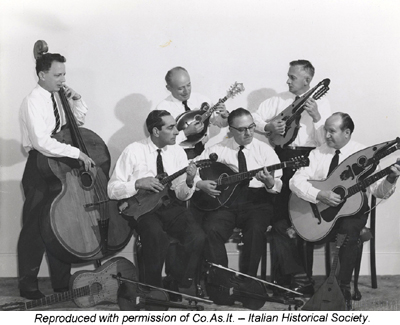 |
 |
| For this
homemade-looking publicity shot photo session of “The Cera Band,”
Giovanni Cera and Frank Zaetta again respectively play the Gibson and
harp mandolin. Rino Cera is
playing his wonderful combo harp guitar/mandolin (note that the
sub-basses are again missing). Mr,
Kost plays a Gibson mandocello and Joe Curcio plays an intriguing
mandola built by Giovanni. |
|
|
|
In November, 1970, Giovanni made the cover of England’s BMG Magazine (at left), posing with his F4 and displaying his own clever combination mandolin and guitar. Giovanni explained that, as he “played live music on various Melbourne radio stations including 3AW, 3LO and 3UZ,” he “thought that changing from one instrument to another was too time consuming and so he created the guitar/mandolin combination in order to go directly from one instrument to another.” Unlike his brother’s, Giovanni’s has no harp strings or harp arm extension. Behind him in the photo is his original harp guitar from c.1930, now with a different pickguard. It’s amazing how well all of the Cera’s instruments held up! The short sketch inside provides a few general details provided by Giovanni. The same two instruments are seen again in this photo at right. |
Giovanni in the backyard of his home at 16-18 Argyle Place North, Carlton, c.1975. |
| About
a decade later in the 1980s, Rino played his last gig with his brother
at the “Royal Melbourne Show” (at
right). Guerino
(Rino) Cera passed away in 1987, but his instruments live on. |
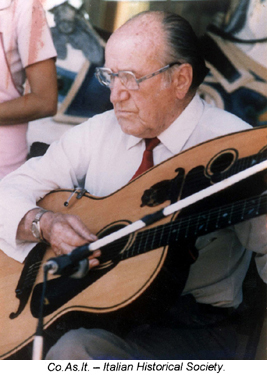
|
|
|
|
His
older
brother Giovanni died three years later on October 22, 1990 in
Melbourne. But even to the very end, he passionately kept up his instrument hobby, as we see him in his workshop touching up his mandola.
|
|
| THE INSTRUMENTS
From the scant sources on the Cera brothers, I’ve gleaned these small pieces of information: |
|
|
Giovanni
supposedly “began making musical instruments in Australia because he
could not find a good mandolin or guitar to play.” That may or may not
be apocryphal. He presumably
could have brought his instruments with him, or sent for them or any
number of Italian-made instruments.
And we know that he later had 1920s Gibsons in his or his
bandmates’ possession (establishing how he came into those might be an
interesting story...). Giovanni “used to visit second-hand furniture depots or music stores to seek out the timber for his instruments.” Indeed, two of his instruments were described – probably by Giovanni originally – as being made from an antique double bass (perhaps the same wood): his harp mandolin made of “timber from an old bass violin,” and his combo guitar/mandolin “from a 150-year-old double bass.” Allegedly, “some
of (Giovanni’s) instruments were sold to musicians in the United
States and England.” Next is a closer look at eleven (or is it twelve?) of the Cera instruments from the above photos, many of which survive (I’ve located just four so far). In many cases, I’m guessing as to the builder (Giovanni or Rino) based on who was seen pictured with it. I have no idea if the brothers additionally might have collaborated on any instruments. I’m assigning them my own arbitrary codes for the sake of discussion and attempting to show in roughly chronological order of their first appearance in historical photographs. I’m using the dates in the Italian Historical Society captions unless otherwise stated or unless clearly errors. For each, I’ll include reference thumbnails of all the verifiable images in which that instrument appears. I’m not including the Form 1 harp guitar in the 1928 “four friends” photo (shown at right), as I don’t believe the Ceras built it. |
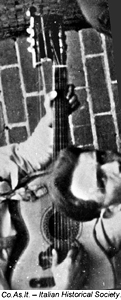
|
|
|
M1-G (Mandolin by Giovanni, c.1930). A carved-top mandolin, obviously Gibson-inspired. I can’t quite make out what is going on at the end of the headstock. I am guessing that this is Giovanni’s creation and one of his very first instruments. |
|
|
|
HG-G1
(Harp Guitar, Giovanni’s first, c.1930).
There are two “c.1930” IHS photos taken at different times in
the Cera’s backyard, each with a similar harp guitar by Giovanni.
To my eye, Rino (with harp guitar) looks notably younger in the
photograph with his sister than he does in the other photo of the
brothers with their dad (with Rino on accordion). I
may be wrong, but regardless, I have chosen to list this instrument
first. It only appears in
this single photograph. Or does it? I now believe that the harp guitar in the early 1940s “costumed group photograph” (played by an unidentified musician) is probably this same instrument, but with a replaced fretboard (as the markers are different) and bridge (or a pearl block installed in the existing bridge). Taking into account the perspective and lighting/photography, everything else looks identical, including the exact pattern of white/black marquetry around the top and sound holes. It all aligns perfectly – not impossible to duplicate precisely on two instruments, but rather unlikely. Note the fancy, carved scroll bass head, the “Cera” in the headstock, the large inlays, the intricately-shaped pickguard and large “checkerboard” top marquetry. I can’t tell what the sub-bass count is. |
|
|
|
|
|
||
|
|
Very
similar to the above is this ornate harp guitar with its nicely carved
scroll bass head containing four sub-basses with geared tuners.
“Cera” is again inlaid on the headstock, and fingerboard
inlays are similarly large and flashy – a bit much for my aesthetic,
personally. The
intricately-shaped pickguard is very similar and the bridge shows a
nicer design as opposed to the plain rectangle of the other.
This harp guitar appears to have a wider body also. |
|
||
|
|
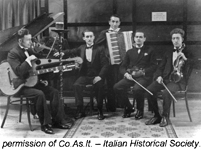 1932 |
 c.1932 |
||
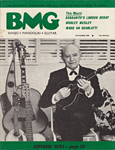 1970 |
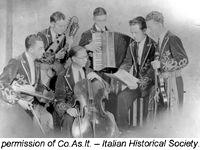 c.1934 |
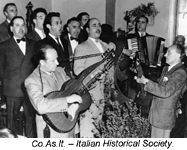 c.1952 |
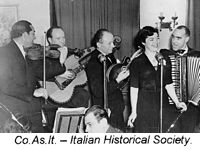 c.1952 (Rino is playing) |
 c.1975 |
|
|
G-R (Guitar by Rino, c.1931) A 6-string guitar that appears in two photos from 1931. The photos show Rino or a friend holding the guitar.
HM-R (Harp Mandolin by Rino, c.1931) Seen in the same two photos as G-R. I’m making a guess that Rino built these two “polka dot” instruments for his own amusement, but it’s possible that his older brother built them. The unusual three increasingly-shrinking arm sound holes may be making their debut here, and would become a distinguishing feature of both brothers’ harp instruments. |
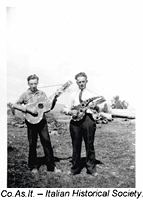 c.1931 |
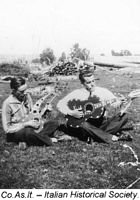 c.1931 |
|
|
|
HG-G3 (Harp Guitar, Giovanni’s third, c.1930s) This
harp guitar may actually be an earlier experiment than HG-G1 as the bass
headstock is a much simpler “cookie cutter” construct. It
also has simpler side-mounted friction pegs for three sub-bass strings.
It has the exact same wood marquetry around the top as Giovanni's
previous instrument (HG-G2), along with similar large inlays including a couple
of “bow ties.” I
show this harp guitar second rather than first simply because it first
appears in the 1934 quartet photo (three years after evidence of HG-G1).
Twenty years later, we see Rino playing it the singers photo, now
with a replaced pearloid pickguard.
The eighty-plus-year-old, well-played instrument survives in this
configuration today (photos courtesy of a private collector in Melbourne
via Ian Watchorn). |
|
|
|
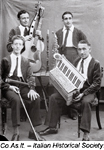 c.1934 |
 c.1952 (Rino is playing) |
|||
|
|
|
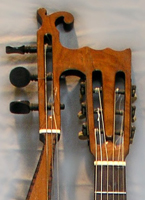 |
|
 |
HG/M-R (Combination Harp Guitar/Mandolin by Rino, 1943) We
know the date of this imaginative instrument because it survives and is
engraved on the back seam "RINO CERA / MADE DEC 19 1943."
It thus dates the first historical photo it appears in as
c.1944-c.1950. We see it again
in the photo session of a Cera brothers group taken sometime in the 1960s,
played by Rino. It also
appears in the final photograph of Rino in the 1980s shortly before his
death, during his last public appearance with his older brother.
I
was thrilled to receive these photos from Brian Allison, curator of the
Grainger Museum Collection, the University of Melbourne (again, thanks to
Ian Watchorn for hooking me up; Ian does restoration work for them).
They acquired it in 2000, 13 years after Rino’s passing, and it
currently shows signs of cracking (plus missing tuners), and thus all
strings are removed. However, notice that in all photos of it from three completely different periods (including when “new”) that it never had its sub-bass strings installed. A look at the extant instrument shows us why. Though perhaps a creative design and clever repurposing of existing hardware, using the tuners from a concert zither and hanging them out in space and expecting this to support sub-bass strings was a bit optimistic! I’m sure Rino tried stringing it up with the intended five sub-basses in the beginning, but quickly realized his mistake. He then just left the tuners on for decoration. |
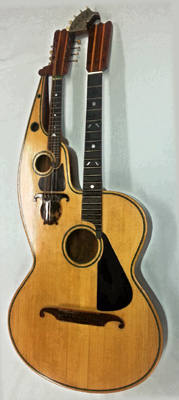 Grainger Museum, the University of Melbourne, used by permission |
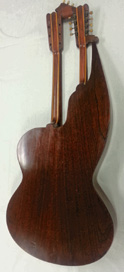 Grainger Museum, the University of Melbourne, used by permission
|
|
What I love about this instrument is that it starts as a typical hollow arm harp guitar, but then the arm itself becomes another harp mandolin with its own hollow arm. If he took it any further, it’d be like those smaller and smaller versions of the Cat in the Hat! Notice how he still managed to get his three reducing sound holes in the arm, utilizing one as the mandolin’s sound hole. I like the scroll at the end of that fingerboard, as well as the decorative tortoiseshell/celluloid pickguard. |
|||
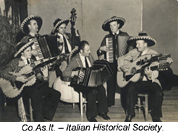 c.1940s |
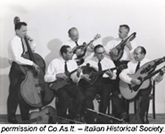 c.1960s |
 c.1960s |
 c.1980s |
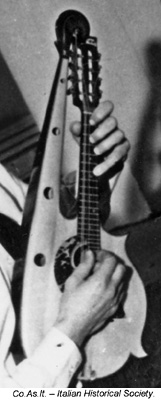 |
HM-G (Harp Mandolin by Giovanni, 1946) This
is the beautiful hollow arm mandolin that brought the Cera brothers to
America’s attention. Clearly
influenced by both the Italian harp guitars and Gibson instruments he
loved, it is a very nice design. Interestingly, though it appears in several different photos, Giovanni is never playing it – his colleague Frank Zaetta is. Giovanni seems to have preferred his Gibson F4. The harp mandolin was donated to the Museum Victoria in 1994 by Giovanni’s brother-in-law Mario Costa. This
instrument was purported to have been built from salvaged wood of an old
upright bass (most likely an apocryphal story provided by Giovanni or
his relatives). The Museum Victoria staff, however, doubts this, as
told here. |
 Museum Victoria |
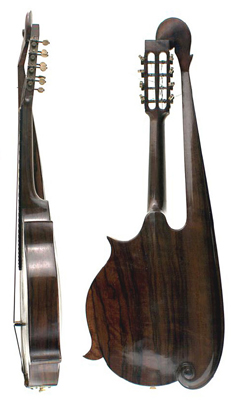 Museum Victoria |
|
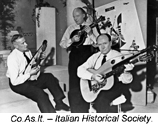 c.1960s |
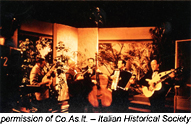 c.1960s |
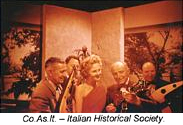 c.1960s |
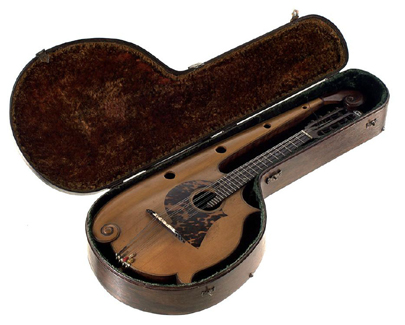 Museum Victoria |
|
 c.1960s |
 c.1960s |
|||
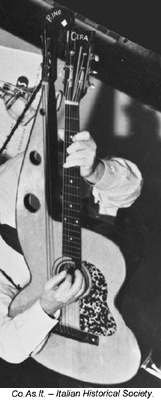 |
HG-R
(Harp Guitar by Rino, c.1960s) I
like it when the brothers make clear who built what!
In this example, Rino inlaid his full name in the bass headstock.
It’s a little more contemporary and sedate than his brother’s
early harp guitars. I
appreciate how they both adhered to their trademark three arm sound hole
motif. This one has three
sub-basses with geared tuners. The
pickguard was changed at some point, and the diamond inlays in the bridge
were enlarged. The current
owner is unknown; the photo of the surviving instrument was taken by
Ballarat, Victoria luthier Sandy Richards in his shop after repair.
Sandy said he repaired another Rino harp guitar as well, but no
photos were taken. I don’t
know if that was the combo harp guitar-mandolin or another, undocumented
instrument. |
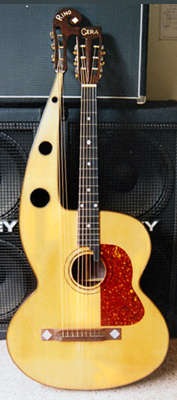 |
||
 c.1960s |
 c.1960s |
 c.1960s |
||
|
|
M-G
(Mandola by Giovanni, late 1960s)
Another
nice instrument built by Giovanni was the carved top, scroll head
mandola that looks like a combination of a Gibson F-style and a Lyon
& Healy violin scroll A-style. Again,
he let one of the other bandmembers play it. |
|
 c.1960s |
 c.1960s |
|
 1990 |
 1990 |
|
|
|
G/M-G (Combination
Guitar/Mandolin by Giovanni, c.1970)
Though this instrument first appears in the 1970 BMG cover photo, it may have been built much earlier. Perhaps learning his lesson from his brother’s attempt, Giovanni omits sub-bass strings on his combo mandolin-guitar. He eschews the hollow arm design as well, opting to have a small round mandolin body literally embedded into the guitar’s upper bout! The connecting
headstock bridge is marked “Cera.” |
|
 1970 |
 c.1975 |
|
| FINE Perhaps we’ll see more of these unique historical instruments
in the future. The rumor is
that various Cera descendants
still own many of them. Maybe
there’s something we haven’t even yet seen!
Thanks:
Jim Garber, Sandy Richards, Ian Watchorn, Brian Allison (Curator,
Exhibitions and Public Programs, Grainger Museum), Paolo Baracchi (Italian
Historical Society, Australia) |
|
If you enjoyed this article, or found it
useful for research, please consider making a donation to The
Harp Guitar Foundation, |
|
|
|
All Site Contents Copyright © Gregg Miner,2004-2020. All Rights Reserved. Copyright and Fair Use of material and use of images: See Copyright and Fair Use policy. |